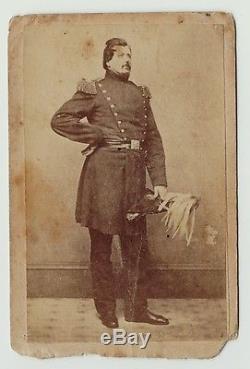RARE CDV Photo Union Civil War Soldier General 1860s Full Pose



For offer, a rare CDV (carte de visite - visiting card)! Fresh from a prominent estate in Upstate NY. Never offered on the market until now. Vintage, Old, Original, Antique, NOT a Reproduction - Guaranteed!! Looks like a name is written on back, faded.
I cant make it out. In good to very good condition. If you collect 19th century Americana history, American military photography, etc. This is a treasure you will not see again!
Add this to your image or paper / ephemera collection. Perhaps genealogy research importance too. The American Civil War, widely known in the United States as simply the Civil War as well as other sectional names, was a civil war fought from 1861 to 1865 to determine the survival of the Union or independence for the Confederacy. Among the 34 states as of January 1861, seven Southern slave states individually declared their secession from the United States and formed the Confederate States of America, known as the "Confederacy" or the "South".
They grew to include eleven states, and although they claimed thirteen states and additional western territories, the Confederacy was never diplomatically recognized by a foreign country. The states that remained loyal and did not declare secession were known as the "Union" or the "North". The war had its origin in the fractious issue of slavery, especially the extension of slavery into the western territories. [N 1] After four years of combat that left over 600,000 Union and Confederate soldiers dead and destroyed much of the South's infrastructure, the Confederacy collapsed and slavery was abolished. Then began the Reconstruction and the processes of restoring national unity and guaranteeing civil rights to the freed slaves.In the 1860 presidential election, Republicans, led by Abraham Lincoln, opposed the expansion of slavery into US territories. The Republican Party, dominant in the North, secured a majority of the electoral votes, and Lincoln was elected president, but before his inauguration on March 4, 1861, seven slave states with cotton-based economies formed the Confederacy. The first six to secede had the highest proportions of slaves in their populations, a total of 48.8% for the six. [5] Outgoing Democratic President James Buchanan and the incoming Republicans rejected secession as illegal.
Lincoln's inaugural address declared his administration would not initiate civil war. Eight remaining slave states continued to reject calls for secession. Confederate forces seized numerous federal forts within territory claimed by the Confederacy.
A peace conference failed to find a compromise, and both sides prepared for war. The Confederates assumed that European countries were so dependent on "King Cotton" that they would intervene; none did and none recognized the new Confederate States of America. Hostilities began on April 12, 1861, when Confederate forces fired upon Fort Sumter, a key fort held by Union troops in South Carolina. Lincoln called for every state to provide troops to retake the fort; consequently, four more slave states joined the Confederacy, bringing their total to eleven. Lincoln soon controlled the border states, after arresting state legislators and suspending habeas corpus, [6] ignoring the ruling of the Supreme Court's Chief Justice that such suspension was unconstitutional, and established a naval blockade that crippled the southern economy.The Eastern Theater was inconclusive in 186162. The autumn 1862 Confederate campaign into Maryland (a Union state) ended with Confederate retreat at the Battle of Antietam, dissuading British intervention. [7] To the west, by summer 1862 the Union destroyed the Confederate river navy, then much of their western armies, and the Union siege of Vicksburg split the Confederacy in two at the Mississippi River. Lee's Confederate incursion north ended at the Battle of Gettysburg. Lincoln issued the Emancipation Proclamation, which made ending slavery a war goal.
[8] Western successes led to Ulysses S. Grant's command of all Union armies in 1864. In the Western Theater, William T.
Sherman drove east to capture Atlanta and marched to the sea, destroying Confederate infrastructure along the way. The Union marshaled the resources and manpower to attack the Confederacy from all directions, leading to the protracted Siege of Petersburg. The besieged Confederate army eventually abandoned Richmond, seeking to regroup at Appomattox Court House, though there they found themselves surrounded by union forces. This led to Lee's surrender to Grant on April 9, 1865. All Confederate generals surrendered by that summer.The American Civil War was one of the earliest true industrial wars. Railroads, the telegraph, steamships, and mass-produced weapons were employed extensively. The mobilization of civilian factories, mines, shipyards, banks, transportation and food supplies all foreshadowed World War I. It remains the deadliest war in American history, resulting in the deaths of an estimated 750,000 soldiers and an undetermined number of civilian casualties. [N 2] One estimate of the death toll is that ten percent of all Northern males 2045 years old, and 30 percent of all Southern white males aged 1840 died.
[10] From 1861 to 1865 about 620,000 soldiers lost their lives. Andrew Hull Foote (September 12, 1806 June 26, 1863) was an American naval officer who was noted for his service in the American Civil War and also for his contributions to several naval reforms in the years prior to the war. When the war came, he was appointed to command of the Western Gunboat Flotilla, predecessor of the Mississippi River Squadron. In that position, he led the gunboats in the Battle of Fort Henry. For his services with the Western Gunboat Flotilla, Foote was among the first naval officers to be promoted to the then-new rank of rear admiral.
Early life Foote was born at New Haven, Connecticut, the son of Senator Samuel A. Foot (or Foote) and Eudocia Hull. [2] As a child Foote was not known as a good student, but showed a keen interest in one day going to sea. [3] His father compromised and had him entered at the United States Military Academy at West Point, New York.
[4] Six months later in 1822, he left West Point and accepted an appointment as a midshipman in the United States Navy. [4] Antebellum naval service Between 1822 and 1843, Foote saw service in the Caribbean, Pacific, and Mediterranean, African Coast and at the Philadelphia Navy Yard. He first began as a midshipman on the USS Grampus. In 1830, he was commissioned a lieutenant, and was stationed in the Mediterranean. [3] In 1837, Foote circumnavigated the globe in the USS John Adams. After serving on sea, Foote was put in charge of the Philadelphia Naval Asylum. After serving on land he went back to sea, and organized a Temperance Society aboard the USS Cumberland. [3] This group developed into a movement that resulted in ending the policy of supplying grog to U. He was active in suppressing the slave trade there. [3] This experience persuaded him to support the cause of abolition, and in 1854, he published a 390 page book, Africa and the American Flag. He also became a frequent speaker on the Abolitionist circuit. [3] Foote was promoted to Commander in 1856, and took command of the USS Portsmouth in the East India Squadron.With this command, Foote was assigned the mission of observing British operations against Canton, China, during the Second Opium War. This eventually resulted in his being attacked from Chinese shore batteries. [3] Foote led a landing party that seized the barrier forts along the Pearl River in reprisal for the attack. [6] This led to a short occupation by the U.
[3] Civil War and his death When the American Civil War began in 1861, Foote was in command of the New York Navy Yard. On June 29, 1861 Foote was promoted to Captain. From 1861 to 1862, Foote commanded the Mississippi River Squadron with distinction, organizing and leading the gunboat flotilla in many of the early battles of the Western Theater of the American Civil War. Even though Foote was an officer in the United State Navy, the Western Flotilla was under the jurisdiction of the Union Army. In early February 1862, now holding the rank of Flag Officer (equivalent to the modern Commodore), he cooperated with General Ulysses S. Grant against Fort Henry on the Tennessee River. Despite heavy damage to one of the gunboats, Foote was able to quickly subdue the fort. Several days later Grant and Foote moved against Fort Donelson on the Cumberland River. Hoping for a repeat of the success at Fort Henry, General Grant urged Foote to attack the fort's river batteries. Fort Donelson's guns, however, were better placed than Fort Henry's were. Three of Foote's gunboats were damaged including the flagship, USS St. Foote himself received a wound in his foot. For his service at Forts Henry and Donelson, Foote received the Thanks of Congress. After repairing his flotilla, Foote joined with General John Pope in a campaign against Island Number Ten on the Mississippi River.In July 1862 Foote received a second Thanks of Congress, this time for the battles of Fort Henry, Fort Donelson and Island Number Ten. [7] Later in 1862, Foote was promoted to rear admiral. [3] In 1863, on his way to take command of the South Atlantic Blockading Squadron, he suddenly died. His untimely death in New York shocked the nation. [8] He was interred at Grove Street Cemetery in New Haven.
[9] Namesakes Three ships were named USS Foote for him. Civil War Fort Foote on the Potomac, [10] now a National Park, was also named for him.The item "RARE CDV Photo Union Civil War Soldier General 1860s Full Pose" is in sale since Monday, February 16, 2015. This item is in the category "Collectibles\Militaria\Civil War (1861-65)\Original Period Items\Photographs". The seller is "dalebooks" and is located in Rochester, New York. This item can be shipped worldwide.
- Country/Region of Manufacture: United States

